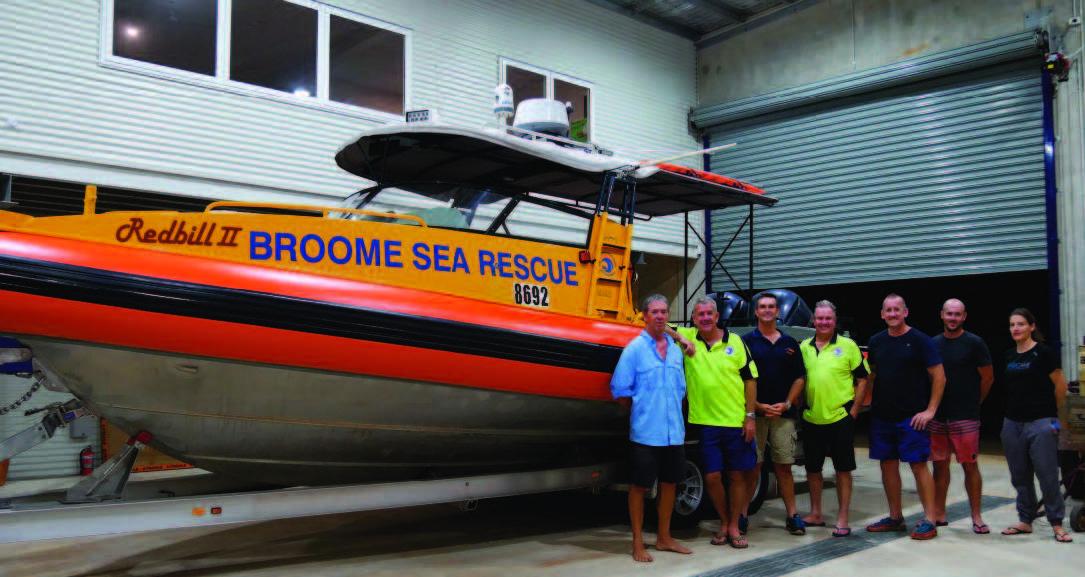2018 - HELP IS ON THE WAY!
Driving down to Entrance Point recently, I noticed a massive concrete building on my right, shadowing the Broome Fishing Club. It wasn’t there six months ago, I’m pretty sure. I contacted the Commander of Broome Volunteer Sea Rescue; Brett Winfield and he invited me to attend a volunteer orientation and training night.
What I discovered was they had been fund raising and looking for the right place to build their rescue facility for over 20 years. Most of that time they simply made do with a shed for their boat and equipment. From there a few dedicated volunteers ventured out to rescue people in trouble on the water. It has been a long journey to complete the building to house their two rescue boats and equipment. There’s also an operation room, training facility and the ability to welcome people under one roof. Oh yes, and it has an awesome view of the water as well.
"Twenty years ago, we operated out of a small room in the Broome Fishing Club with our UHF radio. We did six hour shifts and they were pre mobile phone days. Everything was analogue. We spent a lot of time talking about general boat safety and how to use the UHF radio. We asked people to log on before they went out. We would go down to the boat ramps and conduct public awareness campaigns. We would hand out laminated information cards about how to log on and how to use the radio. We would do radio checks. Sometimes we’d even pull alongside vessels and ask if they wanted to do a radio check. They would usually say, "She’ll be right." We could see that they did not even have an antenna. We tried to educate and inform people. Saying that, we are not regulatory. We don’t check life jackets or flares. That is the Department of Transport's jurisdiction." says Brett.
“In those early days, there was little mobile phone usage or coverage. So, we tried to encourage people to log their journey and log out on the radio when they got back. This sort of worked but it felt like an uphill battle, so after a few years this was stopped.”
“Mobile phone coverage increased, EPIRBS were more in use, and we no longer had the volunteer power to man the radio 24/7. Now we are on call, our mobile phone linking to our landline, as well as the police and emergency services. People in trouble might call a friend who will contact us, otherwise an emergency call to OOO will get us too.”
“The usual scenario is that a wife will be come home from work, thinking her husband will be home from fishing, but has probably gone to a mate’s. She may start ringing around, and by the time she finds they have not returned, it is usually dark. That's about when she will call us. Sometimes we get a call direct from the vessel on their mobile, or from the police if they've activated an EPIRB. It could come from the Water Police or very occasionally from AMSA in Canberra. The Water Police will give us coordinates and a predicted program of where we should search.”
“Some calls are due to engine failure, usually electrical or they just run out of fuel. Strong tides can get sweep boats away very easily. Some people leave shore in thick fog, thinking it will lift and they get completely lost. We’ve brought some back from Eco Beach when they thought they were near town.”
“We receive a lot of call outs in late afternoon and night, and darkness makes finding boats very difficult. We have night vision, infra-red glasses which are only good for about 700 metres. For communication we speak to the Water Police directly via VHF Channel 22. If there is anything sensitive to communicate we will only use a mobile or satellite phone. We use coded messages to convey necessary information, never referring to death or the recovery of bodies. Police have their own codes. We keep our information simple and use generic terms.”
“On average, we are going out once or twice a week. In the past year we’ve made 63 search and rescue training exercises, and between August and mid-September we had 13. During Shinju we had a number of vessels on the water while the Dragon Boat races were held, just to keep an eye on things. When we came back in and were washing down the boat, we received a call out that someone was in trouble 20 nautical miles out, which is a 40 mile round trip. We didn't get back till quite late. We had been on the water from 6 am and did not finish till 8.30 pm. A very long day. Most of our work we call an ‘RAC’ job, the usual breakdown and recovery.”
“We have about 29 volunteers to call on, although not all are active members. We have some who do administrative work instead. One of our volunteers gets horribly seasick, and as she has a cleaning company, she has volunteered to clean the building. Our members come from all types of work environments. Tonight, we had a maintenance technician from TAFE, an Occupational Therapist from the hospital and an operations officer from Clontarf. They all bring different skills to the team. We have navigational training exercises to ensure they are proficient.”
“We are grateful for any time that a volunteer can give us, but we do need about three hours per month out on the water, to keep everyone up to speed. My job is to make sure everyone is capable and confident on the boat.”
“Words cannot describe the feeling you get the first time when you pull someone out of the water, knowing they would have died if you hadn’t been there. The feeling is incredible, and it takes you several hours to come down from such a high. Most volunteers have jobs that would not put them such a position, so the personal rewards are great.”
“We have an RIB inflatable high performance, purpose built rescue boat. Built in 2004, it has had a couple of refits to keep it up to date. Designed specifically for very high speeds, each of these shock absorbing seats is worth around $7,000. The flooring has shock absorbing material. It has a full radio suite, satellite phone and internet on board. The fuel tanks have a 300 nautical mile range. Standard operating procedures for a volunteer rescue group is 30 miles; any further and we must do a risk assessment.”
“There are two apps the coastguard is trialling over east and there is movement afoot to get the most successful implemented Australia wide. Essentially, it will be a free downloaded app, people register their details, boat details, contact details, next of kin, then each trip is logged with an estimated time of return. It sends a reminder to be back in 30 minutes. A response is required and if that doesn’t happen, an alert is sent to the local hazard management authority, which in Broome is the Police. We are hoping to see this implemented soon.”
“It has taken us over 10 years to raise the million dollars to build this facility. We received $250,000 from DFES to build a shed, then over $400,000 from Royalties for Regions, plus $75,000 from Lotterywest. We still had a shortfall, but a note from Melissa Price offering assistance enabled an extra $500,000 which went towards a second boat. She kept her promise!”
“It is wonderful to have this building, in this location overlooking Roebuck Bay. It’s the culmination of a 20 year dream. We can now all come together under one roof in this great volunteer training centre which is here to help the community.”
Brett reckons there are a couple of things you can do to ensure your safety before venturing out onto the waters around Broome.
√ Check the weather and wind report for the day.
√ Know the tides: you don’t want to be stranded.
√ Ensure all your safety equipment – flares, EPIRB and life jackets are in date and functional.
√ Check your boat is mechanically sound.
√ Have enough fuel for the return journey, plus some more.
√ Tell someone where you are going and what time you expect to return. If you don’t check in on time, ensure they act on it.
√ Take your mobile phone and keep it dry. Remember you could be out of range.
√ A working UHF radio is best.
For further information, you can go to their website www.broomesearescue.org.au for all contact details. You may wish to become a volunteer.

